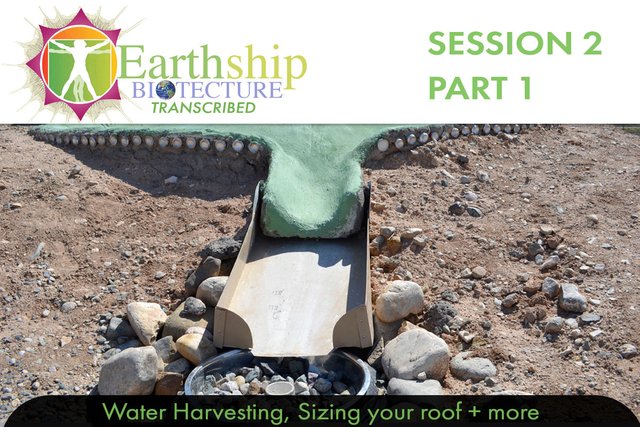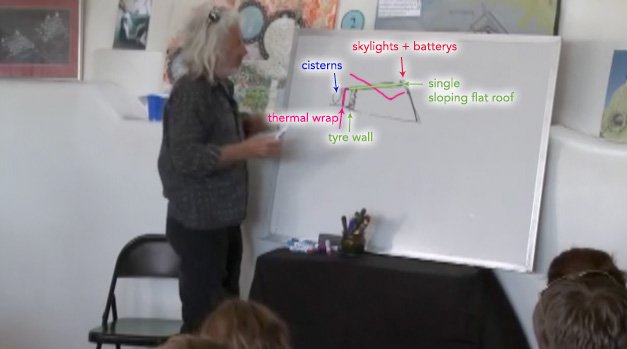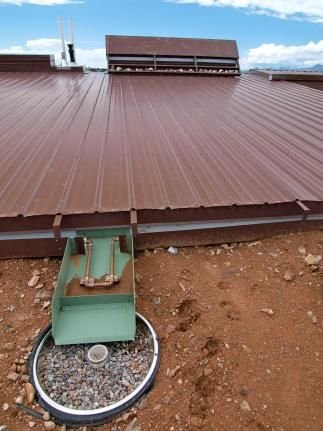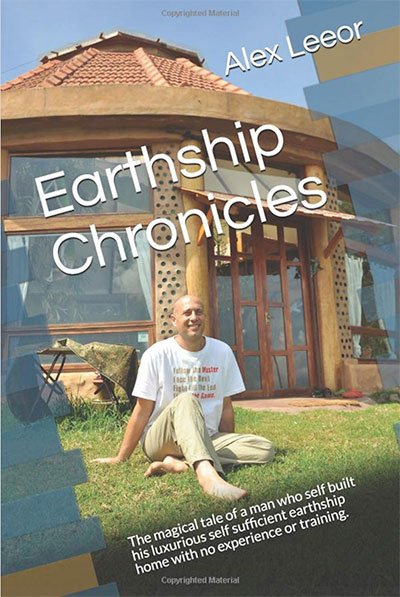Earthship Biotecture Transcribed: Session 2 Part 1: Water, how to size your roof, choosing the right materials for water catchment.

I would like to thank Mike Reynolds for giving me permission to transcribe, edit and reformat this work for the Steem Blockchain! This is part 1 of the second session of a Biotecture seminar. If you do read or watch this and have any questions please ask in the comments. I am happy to educate and help you to understand this. Biotecture is amazing in so many ways, and even after 20 years I still have not seen a model of sustainable building that even comes close in so many important areas such as performance, carbon footprint, longevity, ease of build, etc... Now you can also come to understand what Biotecture Really Is about!
Commentary
This post is all about WATER! The most important and precious resource that we need to survive and live.. wherever you are! Earthships are second to none at not only catching and storing huge quantities of water, but also using it so efficiently and so many times that they are able to survive with only 8 inches or rainfall a year! In this first part you can learn how to calculate how much roof area you need to catch enough water for your location and rainfall. Learn about the right materials to use for roofing and many more aspects relating to understanding how to catch and store enough water for your location. With earthships being able to run on just 8 inches of rainfall a year, there aren't many places on earth where you cant catch enough rain to live comfortably!

Earthship Seminar Transcription Session 2 - Part 1
The water situation starts with the sky. So you're looking at what falls from the sky rather than taking it out of the aquifers ... and that also means rain and snow melt. We also look at what roofing materials to use, and some caution on choosing none toxic metals.
Why the roof is sloped the way it is.

When we were first doing the roofs, just to review a little bit, sloping south to get this to collect the Sun, to melt the snow and then got into the fact that that makes more details and now we're doing this:

So you'll see the the building next door, the education facility, and the one they call corner cottage, has this configuration which works great! It's just more expensive than this so we're obviously headed for, you know, making things more economical... and so this is where we're at now with our skylights and our battery box and everything out here in the front. We just have a very simple roof overhanging dropping into cisterns thermal wrap and tire wall.
What Material To use for the roof?
So looking at the roof first it starts with the roofing material, and I mentioned yesterday to look at this roof which was the bry material with it, and it it started deteriorating and needing an acrylic coating every few years... so we went ahead and spray foamed it, which is not bad... you have to put acrylic coating on it ... but a lot of places around the world don't have the spray foam coating. We're looking at trying to come up with a universal design that has basic qualities that can be used around the world.
So we went next door this was the first building we built out here with next door we went to just a material called EPDM rubber. It lasts for 10 or so years you can see by it next door that it's going to need maintenance soon and then the next building over is when we started going to metal and it got into the fact that metal does create issues because of the detailing... especially with the kick up, so this (single flat slope) configuration of roof was aimed at getting metal which is very stable and it collects even moisture in the cisterns... we've seen it dripping from them, just due... and collects clean water.
It's a very simple lifetime roof you can't really go wrong. So we were into making some design sacrifices... it turned out they weren't sacrifices because now we heat this thing and melt the snow from underneath, and it's the same difference just a lot cheaper. So the roof is the beginning and if you're going to do catch water and water is a big issue these days, so you're looking for, in my opinion after all the years we've been fooling with it, you're looking for a metal roof... and a metal roof that if you are in a climate where it does freeze... then you're looking for heating it with the solar panels that we put up here that also double as hot water heating and we just pipe some of it through underneath the roof to melt. You can get a glimpse of that system at the the latest one called Sutton that Kirsten's going to take you to you can look at on the edge you can see these pipes there's a gutter back here you can see the solar collectors up here back the back there's pump there's a closet where you can see the pump and the and the in the tank that stores the hot water and so on
How much water can I catch on my roof?
So that's the beginning of harvesting water is a roof surface. The square footage of the roof is relative to... I won't do all the math right now... but basically you can do the square footage of your roof and then... that would be also how many cubic feet your roof would be if you had 12 inches of precipitation a year. There's seven gallons in a cubic foot so you can then get how many gallons of water for every inch of rain or every 12inches of rain your roof can collect. Then you can take your annual rainfall in hours you could say ours is 8 here.. it's really probably 7 here on the Mesa but call it 8... that would be 0.66 of a cubic foot, there's 7 gallons and in cubic foot, and do the math and you can find out how many gallons of water a year you can collect then you can sighs your cisterns accordingly.
*MORE INFORMATION*
I am
adding this information to help you calculate your rainfall as Mike does not go through the entire process. It is quite simple!
Simple Rainwater Harvesting Formula Method 1
- For every 1" of rain and 1,000 square feet of impermeable surface (roof, driveway, etc), about 620 gallons are generated.
- Meaning, you can capture about .62 gallons per sq ft.
- To figure out the square footage of a surface, multiply the width x length in inches.
- The square footage of a roof is the same whether it is pitched or flat.
Simple Rainwater Harvesting Formula Method 2
-
Take the dimensions of the footprint of your roof and convert them to inches.
(So, a 50' x 20' roof is 600" x 240".) -
Multiply the roof dimensions by the number of inches of rainfall.
(In this example, 600" x 240" x 1" = 144,000 cubic inches of water.) -
Divide by 231 to get the number of gallons
(because 1 gallon = 231 cubic inches). (144,000/231 = 623.38).
Earthsips Use Water 4 times.
And then due to the fact that this water system uses the water four times, you in a normal household a person... what the calculations from say the State Engineer who calculates the water usage of a person in an average house, it's something like 96 gallons a day. Because we use the water four times ours comes out to be 19 per day and this is off this is certified or whatever... endorsed let's say by the State Engineer of New Mexico. He helped us come up with his figure after I went down there to the state engineer's office, who handles all the water in the state controls all the aquifers and everything, and I said we want to do a catch water system... and he said, this is years ago, and he said, "well that's really cool but there's just not enough water in this that falls from the sky here to do a catch water system".. and I told him what we wanted to do which was... we catch the water in a cistern from the roof, and then we used the water say to take a bath. Then we recollect the water after the greywater planters to flush the toilet that water some indoor plants that's the second use of water. Flushes the toilet... that's a third use of water, and then the toilet water goes outside through a conventional septic system and into another rubber line cell... which you'll see at the Sutton house because there's one under construction there and that does landscaping.
So see when you take a shower that uses say five gallons of brand-new fresh water when you water a bunch of indoor plants for food or decor or whatever that uses another five gallons of fresh water. When you use the toilet that takes another used to be five gallons of water ...they have low flush toilets now and then when you landscape outside again that's brand new fresh water that a normal household uses. We use that same gallon same five gallons of water over and over and over and over again which is how we can come up with this figure.
So then you can say nineteen gallons a day per person and match that to what you can get on your roof and you'll find that two people living in a normal sized house in an area like this that has seven to eight inches of precipitation a year in liquid will work ... and the engine state engineer was super psyched about it because it would cause us to be pumping less water from the aquifers that are waning in New Mexico so he helped us come up with these figures. So that's the basis of it right there, but then the water you're getting the water on the roof.
The next step is you have to get the grasshopper wings and bird shit, and whatever else out of it... dirt and dust. We have silk catches what we've gone through all kinds of silk catches... if you look around at the different roofs you'll see lots of different basins that that begin to collect the water it goes through those on its way to the system. The one we're at now this is after you know a couple of decades of evolution is we went online and you can see this at corner cottage, and I don't think the Sutton one has it in yet. Corner cottage is probably the only place we've got this installed because it's relevant relatively new. You want something that water can run in and it's just gonna filter it basically. In this climate we don't have a bunch of leaves and and things like that, you have to get more serious with your clean-out if you in an area that has a lot of deciduous trees... but here we're just talking about insects and dirt and dust and whatever and pieces of plants or whatever they end up on the roof.
What we found is a big stainless steel bowl online and we went and drilled a bunch of holes in it we fill it full of gravel and we run the scuppers off of the gutter into it and I think they've even got these installed next door so definitely go up and walk around the roof next door.

So your water at the end of of a roof goes into a typical rain gutter sometimes we make them bigger, if it's more if there's more precipitation than a regular gutter. Then that goes into scuppers that just take it into the stainless steel bowls (above image) giant bowls full of gravel and that's the bit that's the first filter it's just a silk catch if you are in an area that has a lot of deciduous trees you put a screen over that that's removable so that the leaves pile up on that and the water goes through and then you can take the screen off and dump the leaves off. You have to in different climates deal with you know the situation a little bit different. Basically you've got two points here already. One is the cleanest material that catches the cleanest water and in low maintenance, and then silk caching to clean up that water... that's the next step.
Another thing about metal roofs there is a brand of metal called pro panel that's sold throughout the US it is the best one because the baked on enamel coating that they use doesn't have lead in it. Some of the other brands... there's a little bit of lead in there baked on coating... and it kind of deteriorates over the years and gets flatter and that deterioration ends up in your water. So the pro panel brand we know you don't really see any pro panel here that's gone flat it's it holds up better. Another good thing to do is test your water occasionally anyway. We've we tested the county used to make us test our water all the time and one time we tested it with a test of the water at the courthouse, which was city water town water, and ours tested better so we aren't getting too much flack about it anymore they're just thrilled that we're not using the aquifers.
So we have our own water and like even if you get to a climate that even has six or five inches of rainfall you can you can come up with a rationalization. We're doing one in Baja now and they they're down there around six or seven and they're having a bigger family in this building so what we're doing is we're just extending the roof even more... you know coming up and they're we're doing little palapas up here that drain onto the roof and whatever. The point being that you can extend your roof surface, with the numbers, doing the math... to match the rainfall to give you what you need for a family of two three four.
Usually if you have a house with two people in it the house is this size, if you have a house with four people living in it the house is that size... so that increases the roof size which equates to the increased use of water, and then you determine how many cisterns. The ones here, we've put in six thousand gallons systems, we use 1,500 gallon cisterns so we use four of them on a typical house. We're doing the same thing in Texas and they get four see we get eight inches of precipitation a year here. Texas where we're going East Texas gets four inches a month three to four inches a month, so one thing we're going to do is tarp the site so we aren't pounding tires in the rain. Pounding tires in the rain for you guys that pounded tires yesterday... imagine your sledgehammer coming back up with a wad of mud on it like that you know, it just doesn't go away. We did that in Scotland.
So this is taking water out of the equation of you know taking from the earth
So the four inches a month means if you do the math on four inches a month these people are catching enough water for two months every month... according to the usage in one of these houses. So this is taking water out of the equation of you know taking from the earth because there's many places the awkward they say the aquifer is under Santa Fe and Albuquerque are going to be deplete in a few years they're going to start taking the Rio Grande. We're good on aquifers here but it's it's 700 feet down and it takes a lot of energy to pump it up, so we don't use it. This community has one well that. The county made us put in over there and it's for fire you know storage of water for fire and it's just a token thing nobody ever uses it.
Desiging Cistern and Sizing
The story there is that if you get less, you know you're heading toward six five four inches.. you increase the roof you. You you look at the biggest torrential rain in recorded history and make your roof and your cisterns size to stash it... for instance like Phil the guy that was pounding tires yesterday, he and I went out a few years back and during a torrential rain... and we saw our roof running into our scupper and basically we saw our cistern running over because there was too much rain all at once. Well in this climate that's a that's a waste... we immediately made our scuppers and our cisterns bigger on her neck design because we don't want to waste a drop of water in this climate. So you want to design your cistern, and it's it's all the same components some are bigger some are larger just like with electricity some of the panels or sometimes you have more panels sometimes you have more batteries I'll go into that... but you're you're looking at designing for the worst torrential rain so that you don't waste a drop of water... unless you're in East Texas and then you can waste rain the cisterns all have overflows so in East Texas I was just gonna put in two cisterns because they're gonna get filled up every month anyway. I went ahead and put in four four just to have you know .. my rationale there was that who knows with climate change if they're going to continue getting three or four inches a month. So but you can if you got more rainfall you can have less cistern and less roof space and if you have less rainfall you have more cisterns a more roof space, its just that simple.
Earthship Seminar Video 2009 - Session 2 -Part 1

READ PREVIOUS TRANSCRIPTS
SESSION 1
Part 1
https://steemit.com/ecotrain/@eco-alex/earthship-biotecture-101-learn-with-michael-reynolds-part-1
Part 3
https://steempeak.com/ecotrain/@eco-alex/earthship-biotecture-transcribed-seminar-with-michael-reynolds-part-3
Part 4
https://steempeak.com/ecotrain/@eco-alex/earthship-biotecture-transcribed-pt4-heating-your-home-with-body-heat-in-norway-about-permits-in-usa-and-europe-how-to-get-them

Did you know, I built four Earthships in India as well as being instrumental the creation of the first Earthship in the UK, Earthship Brighton. If you are also on this path and would like to read my story, I have recently published a book. It is not only a great story, but a valuable resource for you to learn from. I had no experience or training when I embarked on my mission, but managed to successfully build a gorgeous home called Earthship Karuna.
You can buy this book with Steem on the homesteaders co-op. Whilst you are there please do have a look at some of the other products as there are all kinds of great things there!


https://homesteaderscoop.com/product/earthship-chronicles-ebook/
If you don't have any Steem you can also buy the ebook and paperback on amazon.
http://mybook.to/Earthship-Chronicles
or
https://www.amazon.com/Earthship-Chronicles-sufficient-luxurious-experience-ebook/dp/B07MYCBXYB
@ecoTrain
Supporting People Who Help
Make The World A Better Place

Discover previous ecoTrain magazines at @ecoTrain
** Click Here To View Our Passenger Feed**


You've been visited by @porters from Homesteaders Co-op. Such a valuable resource you're sharing here, thank-you! You've already shared so much and now moving into water catchment and usage, superb! Hope this inspires more people to build with as small of footprint as possible! --- A community marketplace of ethical, handmade and sustainable products available for STEEM, SBD (and USD): https://homesteaderscoop.com follow: @homesteaderscoop
A community marketplace of ethical, handmade and sustainable products available for STEEM, SBD (and USD): https://homesteaderscoop.com follow: @homesteaderscoop
Thank u!!
That is really great, efforts there should continuous be made to clean up our planet earth.
Haha... I thought you were all done with Part 8 of Session 1. The level of detail in INCREDIBLE. Gonna be longer than the Lord of the Rings epic though.... :) How blessed are we at all this knowledge being so freely shared! Thank you. x
Leading the curation trail for both @ecotrain & @eco-alex.
Together We’re Making This World A Better Place.
Click Here To Join the manually curated trail "@artemislives" to support quality eco-green content.
@ecoTrain